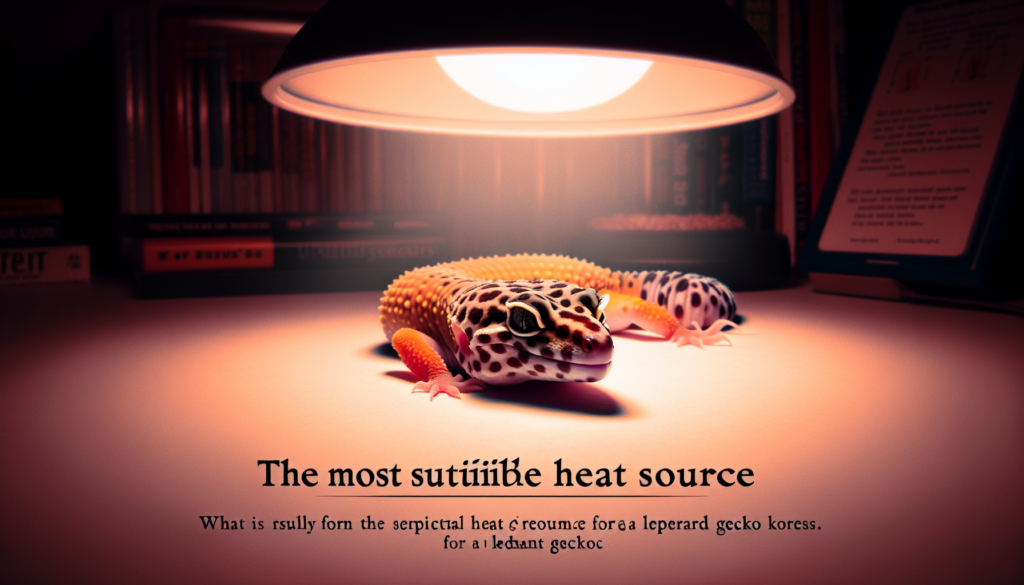If you’re a proud owner of a leopard gecko, you know how essential it is to provide them with the perfect heat source to keep them comfortable and healthy. Whether you’re a seasoned reptile enthusiast or new to the world of leopard geckos, finding the best heat source for your little friend can be a daunting task. With so many options available, it’s important to understand the different factors to consider when making your decision. In this article, we’ll explore the top heat sources for leopard geckos, ensuring that you have all the information you need to create the ideal habitat for your scaly companion.
Factors to Consider When Choosing a Heat Source
When it comes to choosing a heat source for your leopard gecko, there are several important factors you need to consider. These factors will ensure that you provide the ideal temperature and environment for your gecko’s health and well-being. Here are the main factors you should keep in mind:
Temperature
Temperature is perhaps the most crucial factor to consider when selecting a heat source for your leopard gecko. These reptiles require a specific temperature range to maintain their bodily functions and stay healthy. The optimum temperature for a leopard gecko’s enclosure is typically between 88°F (31°C) and 94°F (34°C) on the warm side, while the cooler side should be around 78°F (25°C). It’s essential to choose a heat source that can reliably achieve and maintain these temperatures.
Control
Temperature control is closely related to the previous factor. As a responsible leopard gecko owner, you must ensure that your heat source allows you to accurately control and adjust the temperature inside the enclosure. Some heat sources come with built-in thermostats or temperature control settings, while others may require an external thermostat. Having precise control over the temperature will help you create a comfortable and safe environment for your leopard gecko.
Safety
The safety of your leopard gecko is paramount when selecting a heat source. It’s crucial to choose a heat source that poses no threat to your gecko’s well-being. Avoid heat sources that emit excessive heat, as this can potentially burn or harm your pet. Look for heat sources that are specifically designed for reptiles and have safety features such as auto-shutoff mechanisms. Safety should always be your top priority.
Efficiency
Efficiency refers to how well a heat source can effectively heat your leopard gecko’s enclosure. Some heat sources may be more energy-efficient than others, which can save you money on electricity bills in the long run. Consider the power consumption and heat output of different options to ensure you choose a heat source that provides efficient heating without running up your energy costs.
Cost
Cost is an important factor for many pet owners. While it’s essential to prioritize your leopard gecko’s needs, it’s also important to find a heat source that fits within your budget. The cost of different heat sources can vary significantly, so it’s worth comparing prices and considering any additional equipment or accessories that may be required. Finding a balance between quality and affordability is key.
Different Types of Heat Sources
Now that we’ve discussed the crucial factors to consider, let’s explore the various types of heat sources available for leopard geckos. Each type has its advantages and disadvantages, so it’s important to understand the options before making a decision.
Heat Mats
Heat mats, also known as heat pads or heat tape, are an excellent option for providing gentle and constant heat to your leopard gecko’s enclosure. These mats are designed to be placed beneath the tank or enclosure, providing bottom heat that mimics the warmth of the ground. Heat mats are easy to install and come in various sizes to suit different enclosures. They are energy-efficient and often come with built-in thermostats. However, they may not be suitable for larger enclosures or for geckos that prefer basking.
Ceramic Heat Emitters
Ceramic heat emitters (CHEs) are another popular choice for leopard gecko owners. These emitters screw into a ceramic socket and emit infrared heat without emitting light. Ceramic heat emitters can produce consistent heat and are suitable for both day and night use. They are often used in conjunction with thermostats for precise temperature control. However, they can be expensive to purchase upfront, and the initial cost may be a deterrent for some pet owners.
Heat Lamps
Heat lamps are a common heat source used for reptile enclosures, including those housing leopard geckos. These lamps emit both heat and light, providing a basking spot for your gecko. Heat lamps come in different wattages and can be paired with a dimmer switch or thermostat for temperature control. They are relatively affordable and widely available. However, heat lamps can be quite bright, which may disrupt your gecko’s natural day-night cycle. Additionally, the light emitted may not be suitable for nocturnal leopard geckos, as it can disturb their sleep patterns.
Infrared Heat Bulbs
Infrared heat bulbs are similar to heat lamps in terms of functionality but emit heat without producing as much visible light. These bulbs are designed to provide a localized heat source, making them suitable for creating a basking spot within the enclosure. Infrared heat bulbs can be controlled with dimmers or thermostats for temperature regulation. They are generally more expensive than standard heat bulbs, but they offer a good alternative for leopard geckos that require a basking area without excessive light.
Under Tank Heaters
Under tank heaters, also known as undertank heating pads or UTHs, are similar to heat mats in their function but are typically larger and cover a larger surface area. These heaters are placed underneath the tank or enclosure, providing heat from below. Under tank heaters are efficient and can maintain a consistent temperature gradient within the enclosure. However, it’s important to monitor the temperature closely to prevent overheating. Some substrate materials may insulate the heat, making it less effective.
Radiant Heat Panels
Radiant heat panels are a more advanced and expensive option for heating leopard gecko enclosures. These panels emit gentle, even heat that is spread throughout the enclosure. Radiant heat panels are energy-efficient, provide consistent heating, and can be controlled with thermostats. However, they require professional installation and may not be suitable for smaller enclosures or pet owners on a tight budget.

Determining the Suitable Heat Source for Leopard Gecko
With so many heat source options available, it can be challenging to determine which one is best suited for your leopard gecko. To help you make an informed decision, consider the following factors:
Species Requirements
Different species of leopard geckos may have slightly different temperature requirements. For instance, certain morphs or genetic variations may have specific preferences. Research the specific requirements of your leopard gecko species to ensure you choose a heat source that meets their needs.
Enclosure Size
The size of your leopard gecko’s enclosure also plays a role in selecting the appropriate heat source. Smaller enclosures may benefit from heat mats, while larger enclosures may require more powerful heat sources like ceramic heat emitters or radiant heat panels. Consider the size of your enclosure and choose a heat source that can effectively heat the entire space.
Temperature Gradient
Leopard geckos require a temperature gradient in their enclosure to thermoregulate properly. This means they need a warm side and a cooler side within the enclosure. Consider how each heat source can help you achieve and maintain the desired temperature gradient for your gecko’s well-being.
Budget
Your budget will inevitably influence your heat source decision. Consider the initial cost of the heat source as well as any additional accessories or equipment required. Remember to factor in long-term costs, such as electricity consumption, when comparing different options.
Personal Preference
Lastly, your personal preference as a leopard gecko owner should also be taken into account. Consider the ease of installation, maintenance, and overall aesthetics when selecting a heat source. Choose a heat source that aligns with your preferences and makes caring for your gecko a pleasant and enjoyable experience.
Conclusion
Choosing the right heat source for your leopard gecko is essential for creating a comfortable and healthy environment. Consider factors such as temperature control, safety, efficiency, cost, and your leopard gecko’s specific requirements. Assess the different types of heat sources available, including heat mats, ceramic heat emitters, heat lamps, infrared heat bulbs, under tank heaters, and radiant heat panels. Take into account factors such as enclosure size, temperature gradient, budget, and personal preference. By carefully considering these factors, you can ensure that you provide the best heat source for your leopard gecko’s well-being.

